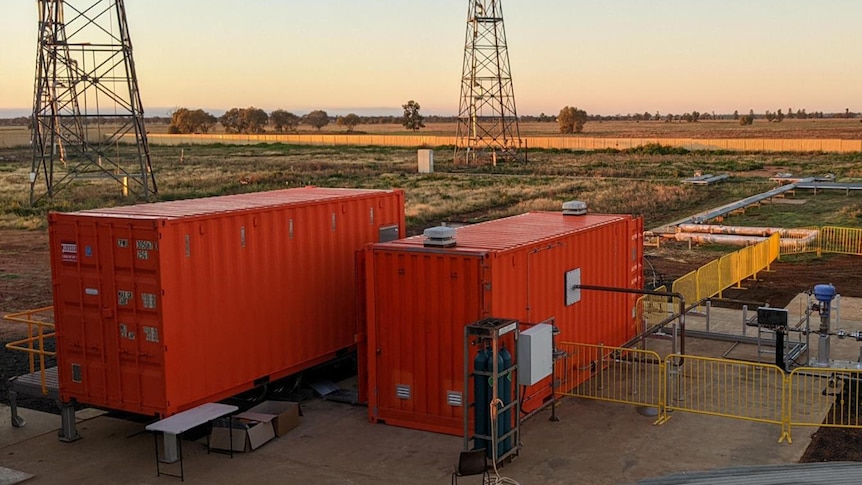When Finland recently unveiled the world’s first “sand battery”, there was speculation that Australian manufacturers would soon be rolling out their own versions, as they looked to burn less gas.
Key points:
- Australia’s first commercial thermal energy storage system will be installed later this year
- It will run on renewable electricity and help a pet food factory cut its use of gas, saving money and reducing emissions
- Similar systems will be rolled out around the country in coming years, experts say
Now, a pet food factory in Wodonga has announced it’s doing just that.
The Mars Petcare facility, one of the largest pet-food makers in the country, will take delivery of a “graphite battery” later this year, as part of a trial to reduce emissions and ultimately save money.
From the outside, the orange container won’t look like much, but experts say the system’s installation is an important moment in the country’s clean energy transition, and such thermal energy storage (TES) facilities will become a common sight over the next decade.
“It will be the first major commercial application of thermal energy storage to displace gas in Australia, so it’s a big deal,” said Dominic Zaal, director of the Australian Solar Thermal Research Institute (ASTRI), which is funded through the Australian Renewable Energy Agency (ARENA).
“It will be the first of many. Within 10 years this will be widespread.”
So, how does it work, and what can it be used for?
Water goes in, steam comes out
Like the Finnish sand battery, the Wodonga TES system purchases renewable electricity from the grid when it’s cheapest and converts this to heat through resistive heating (like an electric bar-heater).
This heat is then stored in the graphite blocks at temperatures of up to 900C.
The modular design can be scaled up. A single container has a capacity of about 3 megawatt-hours of thermal energy, which is equivalent to the amount of electrical energy stored by a large neighborhood chemical battery.
In practice, the battery is designed to be charged and discharged at the same time, which means that over the course of a day it can process up to 8MWh of thermal energy.
When heat is needed, water is run through pipes within the seacrate, and converted to high-pressure steam, at temperatures of 150-250C.
This heat is then used wherever it’s needed. In the case of the Wodonga factory, it will cook pet food.
The clean energy system will reduce the factory’s gas consumption by 20 per cent, said Paul Matuschka, its head of sustainability.
The system is scheduled to begin operation early next year, and more batteries may be installed.
“We’ve got a metric to be 100 per cent renewable from direct operations by 2040,” Mr Matuschka said.
The struggle to get off gas
About 16 per cent of Australia’s emissions are due to the burning of gas in industry for processes needing high temperatures (anything above 100C).
Cutting these emissions requires more than installing solar panels and batteries, as electricity on its own can’t generate high enough temperatures.
Heat pumps (the same technology used by reverse cycle air-conditioners), which can be powered by renewables, max out at about 100C.
TES is seen by many as the solution to this problem.
Mars Petcare Wodonga is a case in point: gas accounts for three-quarters of its energy consumption.
“Over 90 per cent of the natural gas usage is used for cooking,” Mr Matuschka said.
Without TES, the factory can’t get off gas, he said.
“We’re looking at thermal energy storage as a critical component to help us achieve getting to 100 per cent net zero from direct operations.”
Other large manufacturers investigating thermal storage
While the Wodonga project has been in the pipeline for more than two years, interest in TES has tracked the recent hike in gas prices.
Wholesale gas prices have more than doubled since last year, and are forecast to stay high in 2023.
The Wodonga TES system is being made by an Australian company, Graphite Energy, based at Lake Cargelligo in Central NSW.
It’s seen sudden demand in recent months, said CEO Peter Lemmich.
“Now that we’ve seen these increases in price, there’s obviously an enormous amount of interest from people,” he said.
The price increase, he said, has “eliminated the green premium” for TES.
“So going green is no longer a cost impost to the business.”
ASTRI’s Dominic Zaal said he was currently advising some of the largest food and paper manufacturers in the country about TES systems and getting off gas.
“We’ve had interest for a good year or two but in the last three months, since Russia’s excursion into Ukraine… the imperative has been significant.”
“I’ve got at least 10 fairly large firms who are interested in this technology.”
Wodonga trial being watched closely
The time it takes for TES units to pay for themselves through gas savings depended on where a business was getting its electricity, Mr Zaal said.
If they’re buying from the grid, it might take 10 years, but if they’re generating their own it could take as little as five, he said.
“These systems are 30-year systems. Once paid back, it’s pretty much free,” he said.
Mars Petcare had calculated a payback period of 10-12 years, Mr Matushcka said.
Other businesses were closely watching the Wodonga factory trial, Graphite Energy’s Peter Lemmich said.
“Everyone that we speak to knows that this project is going ahead and they’re all sort of kind of sitting back going, let’s have a look at that.
“And if that does what you said it’s going to do, then, you know, we want to talk.”
.
